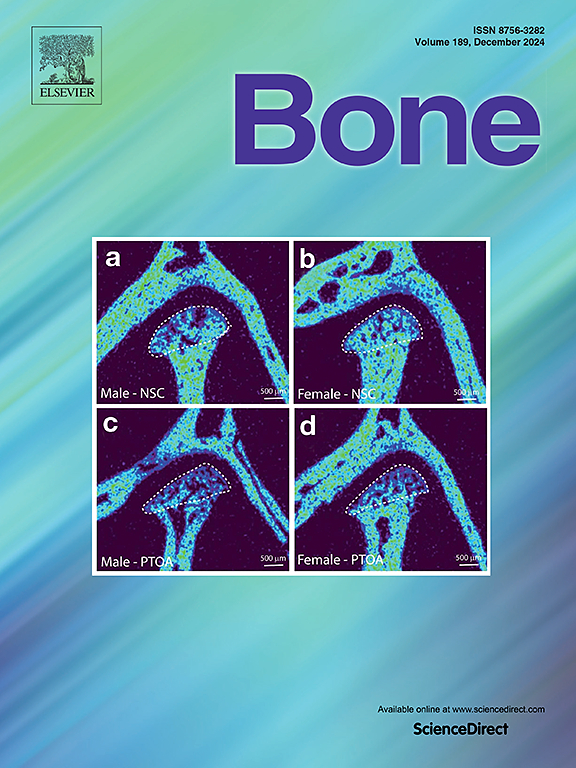唑来膦酸钠给药途径对啮齿类动物模型BRONJ重现性的影响:系统综述。
IF 3.6
2区 医学
Q2 ENDOCRINOLOGY & METABOLISM
引用次数: 0
摘要
目的:双膦酸盐相关性颌骨骨坏死(BRONJ)是一种衰弱性疾病,其特征是与双膦酸盐药物(如唑来膦酸盐)相关的牙槽骨破坏。唑来膦酸钠的使用与BRONJ的发病率增加有关。在啮齿动物模型中,BRONJ分期的准确复制取决于唑来膦酸钠给药途径。本系统综述通过分析不同唑来膦酸钠注射途径对临床、组织病理学和放射学结果的影响,评估了啮齿动物模型BRONJ特征的可重复性。方法:采用BRONJ和唑来膦酸钠相关关键词,根据系统评价和meta分析指南的首选报告项目进行系统文献检索。从选定的研究中收集以下数据:小鼠和大鼠的特征;唑来膦酸钠的剂量、持续时间和给药途径。BRONJ分期在这些研究中是根据牙槽骨坏死的临床、组织病理学和影像学特征来确定的。结果:唑来膦酸钠治疗显著影响BRONJ特征的重现性。小鼠和大鼠在产生BRONJ方面表现出不同的特征,这取决于唑来膦酸钠注射途径。大鼠皮下、腹腔和静脉注射均产生暴露的牙槽骨,这是临床BRONJ的主要标准。唑来膦酸钠注射液和静脉注射建立小鼠BRONJ临床模型。小鼠和大鼠均未表现出BRONJ特征的性别差异。结论:啮齿类动物BRONJ模型与人类BRONJ的分期和特征相似。为达到特定的研究目的而量身定制唑来膦酸钠给药途径时,大鼠BRONJ模型的重复性更加一致。本文章由计算机程序翻译,如有差异,请以英文原文为准。
The effects of Zoledronate administration routes on the reproducibility of BRONJ in rodent models: A systematic review
Objective
Bisphosphonate-related osteonecrosis of the jaw (BRONJ) is a debilitating condition characterized by alveolar bone destruction associated with bisphosphonate medications, such as zoledronate. Zoledronate use is associated with an increased incidence of BRONJ. In rodent models, accurate replication of BRONJ stages depends on the route of zoledronate administration. This systematic review evaluates the reproducibility of BRONJ characteristics in rodent models by analyzing the effects of different zoledronate injection routes on clinical, histopathological, and radiological outcomes.
Methods
A systematic literature search was conducted according to the Preferred Reporting Items for Systematic Reviews and Meta-Analysis guidelines using keywords related to BRONJ and zoledronate. The following data were collected from the selected studies: characteristics of mice and rats; zoledronate dose, duration, and route of administration. The BRONJ stage was determined in these studies based on clinical, histopathological, and radiological features of alveolar bone necrosis.
Results
Zoledronate treatment notably affected the reproducibility of BRONJ characteristics. Mice and rats exhibited distinct characteristics in producing BRONJ, depending on the route of zoledronate injection. Subcutaneous, intraperitoneal (IP), and intravenous (IV) injections in rats consistently produced exposed alveolar bone, the main criterion for clinical BRONJ. IP and IV zoledronate injection in mice produced a clinical BRONJ model. Neither mice nor rats exhibited differences in BRONJ characteristics according to sex.
Conclusions
Rodent models of BRONJ mimic the staging and characteristics of BRONJ observed in humans. Rat BRONJ models were more consistently reproducible when the zoledronate administration route was tailored to achieve specific research objectives.
求助全文
通过发布文献求助,成功后即可免费获取论文全文。
去求助
来源期刊

Bone
医学-内分泌学与代谢
CiteScore
8.90
自引率
4.90%
发文量
264
审稿时长
30 days
期刊介绍:
BONE is an interdisciplinary forum for the rapid publication of original articles and reviews on basic, translational, and clinical aspects of bone and mineral metabolism. The Journal also encourages submissions related to interactions of bone with other organ systems, including cartilage, endocrine, muscle, fat, neural, vascular, gastrointestinal, hematopoietic, and immune systems. Particular attention is placed on the application of experimental studies to clinical practice.
 求助内容:
求助内容: 应助结果提醒方式:
应助结果提醒方式:


